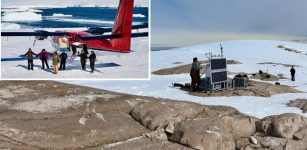Early Life On Earth Shaped By Sea Level Changes – New Study
Eddie Gonzales Jr. – MessageToEagle.com – Continental plate shifts affecting sea levels likely influenced early animal evolution, according to a study.
Scientific researchers are conducting field investigations in Namibia to analyze paleontological evidence of animal fossils. These specimens are estimated to be approximately 550 million years in age. The study aims to contribute to our understanding of ancient fauna and geological history.
Researchers examine evidence of animal fossils, which are about 550 million years old, in field work in Namibia. Image credit: Rachel Wood
This study reveals clues into the forces that drove the evolution of the earliest organisms, from which all major animal groups descended. A new timeline of early animal fossils links sea levels, marine oxygen changes, and the emergence of the earliest animal ancestors.
A team from the University of Edinburgh studied rocks and fossils from the so-called Ediacaran-Cambrian interval, a slice of time 580–510 million years ago. According to fossil records, this period witnessed an explosion of biodiversity, the causes of which have baffled scientists since Charles Darwin.
Early animals from this era were sea-dwellers, living when oxygen levels were much lower than today.
Unlike previous single-cell or simple multi-celled organisms, Ediacaran creatures developed complex body plans, enabling feeding, reproduction, and movement across the ocean floor. This era also marked the emergence of so-called bilaterian animals – which display symmetrical body plans, in common with most present-day species including humans.
By compiling data from different sources – including radioactive dating and geochemical information about the layers of rock in which fossils were found – the team mapped all major fossil finds and various environmental datasets onto a single timeline.
It allowed the team to study trends in biodiversity for the period in question with more detail than before.
They linked major sea level changes and increased oxygen in shallow marine environments to the emergence and diversification of early animal groups, using chemical evidence from geological records.
This dynamic set the stage for several significant bursts in biological diversity, known as the Avalon, White Sea, and Cambrian assemblages, each marking the arrival of new animal groups and the decline of others.
According to a press release, by ‘reconstructing environmental conditions in the deepest time, the study unlocks new insights into the ancient forces and pressures that shaped the earliest life on our planet.’
The team also identified gaps in the fossil record, suggesting that current knowledge about early animals is biased by the clusters of sites worldwide where fossils have been found and studied.
Written by Eddie Gonzales Jr. – MessageToEagle.com Staff Writer











